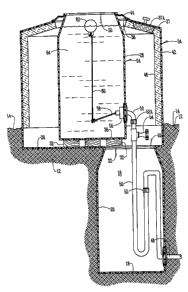Une partie des informations de ce site Web a été fournie par des sources externes. Le gouvernement du Canada n'assume aucune responsabilité concernant la précision, l'actualité ou la fiabilité des informations fournies par les sources externes. Les utilisateurs qui désirent employer cette information devraient consulter directement la source des informations. Le contenu fourni par les sources externes n'est pas assujetti aux exigences sur les langues officielles, la protection des renseignements personnels et l'accessibilité.
L'apparition de différences dans le texte et l'image des Revendications et de l'Abrégé dépend du moment auquel le document est publié. Les textes des Revendications et de l'Abrégé sont affichés :
| (12) Brevet: | (11) CA 2198647 |
|---|---|
| (54) Titre français: | ABREUVOIR A BESTIAUX RESISTANT AU GEL |
| (54) Titre anglais: | FREEZE RESISTANT LIVESTOCK WATERER |
| Statut: | Périmé |
| (51) Classification internationale des brevets (CIB): |
|
|---|---|
| (72) Inventeurs : |
|
| (73) Titulaires : |
|
| (71) Demandeurs : |
|
| (74) Agent: | RIDOUT & MAYBEE LLP |
| (74) Co-agent: | |
| (45) Délivré: | 2002-04-30 |
| (22) Date de dépôt: | 1997-02-27 |
| (41) Mise à la disponibilité du public: | 1997-11-14 |
| Requête d'examen: | 1997-02-27 |
| Licence disponible: | S.O. |
| (25) Langue des documents déposés: | Anglais |
| Traité de coopération en matière de brevets (PCT): | Non |
|---|
| (30) Données de priorité de la demande: | ||||||
|---|---|---|---|---|---|---|
|
Il s'agit d'un abreuvoir à bestiaux dont un premier compartiment est enfoui sous le niveau du sol; une conduite d'eau sous pression y entre. Un second compartiment est monté au-dessus du premier et au-dessus d'une ouverture, pratiquée dans la partie supérieure du premier compartiment, de telle sorte que l'air dans le premier compartiment communique avec l'air entourant le second compartiment. Un troisième compartiment, dont la partie inférieure est aussi enfouie dans le sol, entoure le second compartiment, sa partie supérieure, ouverte, communiquant avec la partie supérieure, également ouverte, du second compartiment. La conduite d'eau dans le premier compartiment communique avec l'intérieur du second compartiment. Un clapet à flotteur sur la conduite d'eau assure la régulation du niveau de fluide qui entre dans le second compratiment. Une enceinte flexible entoure l'espace entre l'ouverture dans le second compartiment et l'ouverture dans le troisième compartiment. Aucun élément chauffant ne se trouve dans l'un ou l'autre des trois compartiments.
A livestock waterer has a first compartment which is
typically buried below ground level and has a pressurized
water line entering therein. A second compartment is mounted
above the first compartment and over an opening in the top of
the first compartment so that air in the first compartment is
in communication with the air surrounding the second
compartment. A third compartment with its bottom portion
also buried in the earth surrounds the second compartment and
has an open top communicating with an open top of the second
compartment. The water line in the first compartment is in
communication with the interior of the second compartment. A
float valve on the fluid line controls the level of fluid
entering into the second compartment. A flexible skirt
device surrounds the space between the opening in the second
compartment and the opening in the third compartment. The
three compartments are free from heat elements.
Note : Les revendications sont présentées dans la langue officielle dans laquelle elles ont été soumises.
Note : Les descriptions sont présentées dans la langue officielle dans laquelle elles ont été soumises.

Pour une meilleure compréhension de l'état de la demande ou brevet qui figure sur cette page, la rubrique Mise en garde , et les descriptions de Brevet , États administratifs , Taxes périodiques et Historique des paiements devraient être consultées.
| Titre | Date |
|---|---|
| Date de délivrance prévu | 2002-04-30 |
| (22) Dépôt | 1997-02-27 |
| Requête d'examen | 1997-02-27 |
| (41) Mise à la disponibilité du public | 1997-11-14 |
| (45) Délivré | 2002-04-30 |
| Expiré | 2017-02-27 |
Il n'y a pas d'historique d'abandonnement
Les titulaires actuels et antérieures au dossier sont affichés en ordre alphabétique.
| Titulaires actuels au dossier |
|---|
| WINEBRENNER, RICHARD L. |
| Titulaires antérieures au dossier |
|---|
| S.O. |